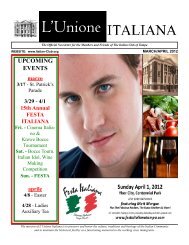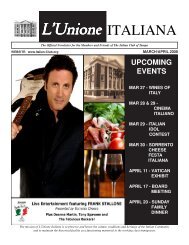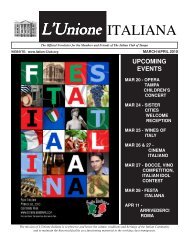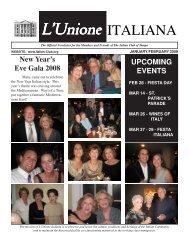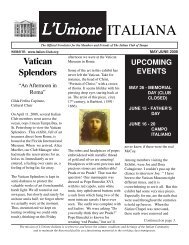Create successful ePaper yourself
Turn your PDF publications into a flip-book with our unique Google optimized e-Paper software.
NOVEMBER/DECEMBER 2004BERKELEY,CA -- Researchers at theU.S. Department <strong>of</strong> Energy’s LawrenceBerkeley National Laboratory havediscovered the mechanism by which anextremely rare protein mutation shieldspeople from cardiovascular disease.<strong>The</strong> discovery could lead to more potentdrug therapies that both targetcholesterol deposition and preventfuture accumulation.<strong>The</strong> mutation enables the protein to curboxidation, a harmful process in whichmolecules with unpaired electrons, alsocalled free radicals, scavenge electronsfrom healthy tissue. It’s believed to playa role in such diverse diseases asAlzheimer’s, osteoporosis, and a form <strong>of</strong>heart disease known as atherosclerosis.In the latter disease, free radicals grabelections from lipids that line arterywalls, sparking an inflammatoryresponse that paves the way forcholesterol deposition. <strong>The</strong> mutatedprotein, however, boasts an antioxidantin the form <strong>of</strong> a sulfur-based residue thatmops up unpaired electrons andprevents them from triggering arterialinflammation, according to John K.Bielicki <strong>of</strong> Berkeley Lab’s Life SciencesDivision.Bielicki’s research solves a paradox thathas puzzled the medical world since1980, when a middle-aged <strong>Italian</strong> manwas referred to Milan’s Lipid Centerwith high blood triglyceride levels, arisk factor for heart disease. Furthertesting revealed the patient alsopossessed very low levels <strong>of</strong> highdensitylipoprotein (HDL), a goodcholesterol that exports excesscholesterol from coronary arteries. Thisprocess prevents plaque buildup thatimpedes blood flow and contributes toheart attacks.A RARE PROTEIN MUTATION OFFERSNEW HOPE FOR HEART DISEASE PATIENTSScience Contact: John, Bielicki, (510) 495-2208, jkbielicki@lbl.govMedia Contact: Dan Krotz, (510) 486-4019, dakrotz@lbl.govSubmitted by Ken FerlitaPatients with low levels <strong>of</strong> HDL aresusceptible to heart disease, yet the<strong>Italian</strong> exhibited no signs <strong>of</strong> pathology.This unlikely combination intriguedscientists, who determined that thepatient and a few dozen people from hisregion possess a mutated form <strong>of</strong>apolipoprotein A-I protein.This important protein, known as apoA-I, both manufactures HDL particles andis responsible for their structure. In themutated form, dubbed apoA-I Milanobecause <strong>of</strong> its origin, one <strong>of</strong> the protein’samino acids is replaced with an aminoacid cysteine that has a sulfhydrylgroup. Somehow, this tiny changeenables a handful <strong>of</strong> <strong>Italian</strong>s to possesslow HDL levels and remain free <strong>of</strong>cardiovascular disease. But how?In pursuit <strong>of</strong> the answer, mostresearchers have focused on the mostcommon form <strong>of</strong> the protein. About 70percent <strong>of</strong> proteins with the Milanomutation come in pairs: one proteinattaches to another to form a dimericPAGE 28complex. <strong>The</strong> key to this pairing is adisulfide bridge in which the sulfhydrylgroup from one protein links with thesulfhydryl from another. This pairingrestricts HDL size and growth and hasbeen attributed to the HDL deficiencyobserved in people who have themutation.But 30 percent <strong>of</strong> proteins with theMilano mutation don’t form dimericcomplexes. <strong>The</strong>y remain unattached asmonomeric complexes. In this soloconfiguration, the sulfhydryl isn’toccupied in a disulfide bond. It’s free,which enables it to partake in otherreactions, says Bielicki. And one <strong>of</strong>these reactions is quenching ions withunpaired electrons. In other words, thefree sulfhydryl form <strong>of</strong> the Milanomutation is a powerful antioxidant, andBielicki had a hunch it played a role inthe mutation’s ability to fightcardiovascular disease.In a laboratory setting, he compared themutated protein with the normal apoA-Iprotein, and determined that only themonomeric form <strong>of</strong> the mutationprotects lipids from oxidation. Thisconfirmed Bielicki’s hypothesis. Inmost people, free radicals can gounchecked as they grab electrons fromlipids that line arterial walls. But for theless than 50 people lucky enough topossess the Milano mutation, themonomeric form, with its freesulfhydryl, mops up free radicals’unpaired electrons. This satisfies freeradicals’ need to scavenge electrons813-884-2382 from arterial lipids an prevents a series<strong>of</strong> reactions that lead to cholesterol(ONE BLOCK NORTH OF HILLSBOROUGH AVE.) deposition.A handful <strong>of</strong> villagers from this <strong>Italian</strong> town,Limone sul Garda, possess an extremelyrare protein mutation that protects themfrom atherosclerosis.“We identified a new activity associatedwith the Milano protein that suggestsContinued on page 29.



